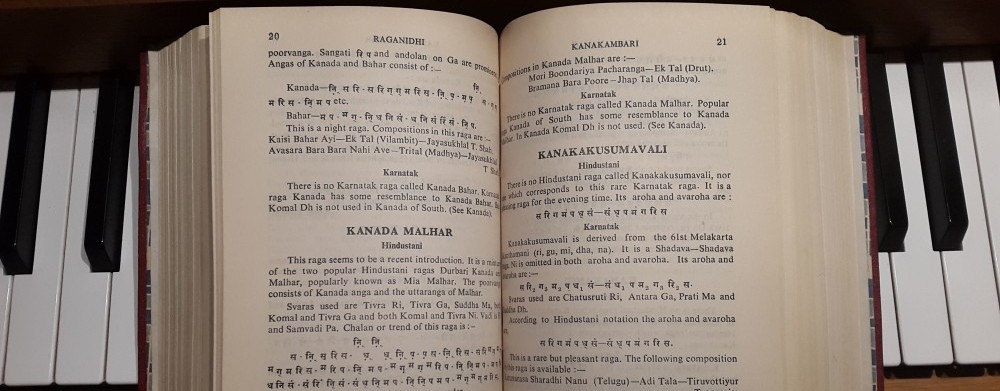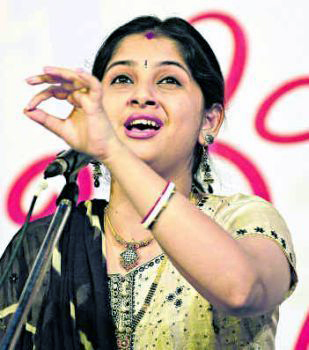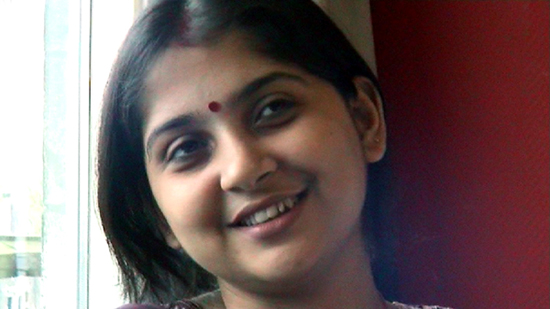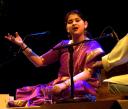On 21 september 2008, the Belgian Radio 2 hour-programme Hemel en Aarde (Heaven and Earth) features Indian classical music by some of my favourite top artists in North Indian hindusthani music, with an unreleased recital by ragasinger Kaushiki Chakrabarty. She’s accompanied on tabla by Samar Saha and on harmonium by her husband, Parthasarathi Desikan. It concerns a live concert recorded on 3 october 2004 at Continue reading
Tag Archives: Kaushiki Chakrabarty
Kaushiki Chakrabarty in World Routes Sat. 6 sept. 2008, BBC Radio 3
Kaushiki Chakrabarty
This year’s spring I reported in a blog on the Darbar Festival 2008 in Leicester that I considered Kaushiki Chakrabarty’s breathtaking concert as the festival’s absolute highlight. When renowned music journalist/radio producer Jameela Siddiqi Continue reading
Added on Youtube : Kaushiki Chakrabarty – Raag Hamsadhwani-composition in teentaal
Two days ago I published one more video on Youtube of Kaushiki Chakrabarty’s dazzling concert on April 15th, 2007, in Amsterdam.
She performs a composition in teentaal in raag Hamsadhwani. Kaushiki is accompanied on tabla by Subashish Bhattacharya and on harmonium by Vyasmurti Anandteerth Katti. On tanpura: Julia Ohrmann. Concert in The Royal Tropical Institute, Amsterdam, April 15th, 2007. It’s a must-see and -hear for all lovers of Kaushiki’s singing.
Copyright of this video: Pieter de Rooij, Tonal Ties Productions.
Click here to watch my other video’s on youtube.
Youtube ‘promo video’ on ‘Gharana’, my radio programme on North Indian classical music
I’ve just published a Youtube-video for promoting ‘Gharana’, my own radio programme on dutch music-radiostation De Concertzender.
Indian classical music vibrant and alive at Leicester’s Darbar Festival 2008!

It’s been more than a week now that I’ve had a great time in Leicester, England, as a visitor of the Darbar Festival 2008. This year it was the third edition of the Festival. I’d heard already a lot of things about ‘Darbar’. Not only several people told me about it, but of course I had also listened to the music itself on many great ‘Darbar-albums’ released by Sense World Music in 2006 and 2007. But being there at the festival is the real thing of course, so I simply had to go to Leicester. What I got there was a unique musical experience and much more than I ever could’ve dreamed of.

participating artists of Darbar 2008 together on stage, at the closing of the festival (photo: Pieter de Rooij)
A knowledgeable, involved and dedicated audience
The Darbar Festival has some very special features and differs from any other festival of Indian classical music, except for, maybe, the Saptak Festival in India, that shares the same philosophy and views. During three days Darbar offers 15 concerts. I’ve attended 12 of them, and one Darbar-unplugged concert before the festival. Top artists from India and from the UK enter the stage. They perform not only for a very knowledgeable, involved and dedicated audience, but also for the other Darbar artists, so the artists visit each other’s concerts. This creates a very special, stimulating atmosphere for the artists on stage.

ragasinger Kaushiki Chakrabarty performing at Darbar Festival 2008 (photo: Arnhel de Serra)
In Amsterdam, here in Holland, I’ve been visiting ragaconcerts for more than 25 years, and it’s always been a really good and dedicated audience, but you’ll never find an atmosphere in Amsterdam comparable to the Darbar-audience, whose response to the artists -with gestures and vocal reactions- is -like in India- much more direct and spontaneous.

participating artists at the Darbar Festival 2008, poster 1
Bringing on stage a new generation of excellent young musicians
The programme schedule of Darbar is really exciting, with a very good selection of the very best young stars, combined with excellent young top performers who may well be on the verge of an international breakthrough. This doesn’t mean that the older artists with the ‘big reputation’ are not coming to Darbar. Some of them do perform at Darbar as well, but apparantly, for the organizers it’s not an issue, a must or a necessity to have them by all means at Darbar to make the festival a success. The great thing is that Darbar doesn’t focus obsessively on the older generation -like so many other venues and festivals do out of mere ‘safety’ or marketing reasons or, otherwise, wrong views- but is breaking away from this old fashioned idea that only old artists can offer the best in Indian classical music, which is simply untrue. As are other persistent ideas, that the spiritual element of the music is vanishing among younger performers and that their musical skills are not as good as the older generation. These persisting ideas -kept alive especially in the media and interconnected ‘markets’ around them- are not only wrong, but do also harm the viability of Indian classical music and could even endanger the continuation of this vulnerable, but nonetheless strong musical tradition. Ravi Shankar and Ali Akbar Khan… when did their stardom and their great reputation start? Exactly, almost fifty-five years ago! The media -and the majority of their users- tend to forget this and in so-doing create and perceive a wrong picture of Indian classical music, namely, as a musical domain exclusively dominated by old stars. This widespread misconception is courageously counteracted by Darbar -and for instance by the Sense World Music label- by bringing on stage a new generation of excellent young musicians.
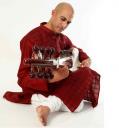
sarod player Tarun Jasani, one of the great young players at Darbar 2008 (photo: from Tarun Jasani’s website http://tarunjasani.com/ )
And that a younger generation can sometimes sound slightly different or seeks new ways of expressing themselves shouldn’t be a reason for immediate criticism -as so often unjustly occurs- but rather be seen as a consequence of music’s natural flow and evolution through time and history. Just think for example in this regard of Indian classical music’s development outside of the domain of royal courts, after 1947. The musicians had to face up new challenges to survive and keep the music alive. And what happened from there was marvellous, the performance-format that evolved -the modern ragaconcert- conquered a worldwide audience!

participating artists at the Darbar Festival 2008, poster 2
Unplugged concert
Now, who were playing at Darbar? Too many to name them all here, but there’s a programme schedule on the web and on the two posters above you can have a look at most of them (with all names listed on poster 1). I’d like to mention here a few of my personal highlights. On Wednesday 2nd of April, two days before the festival started, I was already in Leicester and visited a so-called ‘Darbar unplugged’-concert, in the Leicester Guildhall, a beautiful old medieval building, with an excellent performance venue. Playing there were two celebrities, Irshad Khan on sitar and surbahar, accompanied on tabla by Yogesh Samsi. Their great, inspired playing was very rewarding and pleasing to the ears, helped also by the excellent acoustics of the venue and the unplugged/unamplified sound of the instruments. The instruments sounded as natural as they should, evry colour and little detail could be heard.
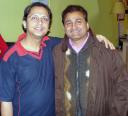
(tabla player Yogesh Samsi [left] and harmonium player Ajay Joglekar [right], meet on thursday April 3rd, 2008, in Leicester
(photo: Pieter de Rooij)
Exceptional performance by Kaushiki Chakrabarty
The Darbar Festival itself was from Friday 4th of April to Sunday 6th of April. The concerts I visited were all great, and four of them I consider my ‘personal favourites’: on friday morning Rakesh Chaurasia’s bansuri-concert with Yogesh Samsi on tabla, on saturday evening the tabla-soloconcert by Bhupinder Sing Chaggar (he’s from Leeds, UK), accompanied on harmonium by Ajay Joglekar and on sunday evening Purbayan Chatterjee’s sitarconcert with -once more- Yogesh Samsi, on tabla. And then there was in my opinion an exceptional festival highlight: the performance on saturday evening of 28-year old singer Kaushiki Chakrabarty from Calcutta, accompanied by Sanju Sahai on tabla and by Ajay Joglekar on harmonium. Soon after hitting the first notes of raag Abhogi right up until the very last note of a light classical song that ended Kaushiki’s concert, the whole audience was spellbound and completely immersed in her singing. I should mention in particular Kaushiki’s deeply moving rendition of a charmingly beautiful melody in raag Pahadi, strongly associated with nature and expressing a painful separation of lovers. There was maximum response -lively gestures, enthusiastic vocal reactions, numerous applauses- from the audience during the performance and a tumultuous applause afterwards.
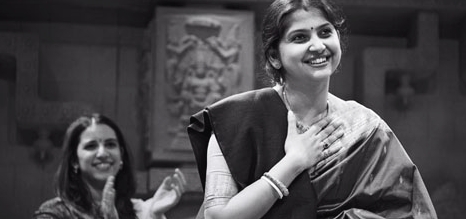
loud applause and cheers raining down on Kaushiki Chakrabarty after her breathtaking performance at Darbar 2008 (photo: Arnhel de Serra)
I’ve heard Kaushiki live before in a dazzling performance in Amsterdam and evrything else I’ve heard of her on cd has been no less than mindblowing. Now in Leicester it was even much, much more than that. Kaushiki’s Darbar-concert was truly the most profound and deeply touching musical experience I’ve ever had. Veeery exceptional!

(Kaushiki Chakrabarty after her performance at Darbar 2008, next to her tanpura-players Debipriya Das [left] and Ranjana Ghatak [right] (photo: Pieter de Rooij)
Interviews at Darbar for my upcoming programmes
So, Darbar was a great experience. I didn’t only visit concerts, but I also had the privilege to interview three great musicians during my stay in Leicester: Irshad Khan, Yogesh Samsi and Purbayan Chatterjee. I’ll portray them in three specials of my radioprogramme ‘Gharana’, later on this year. You’ll soon find more details on these programmes here on my weblog and on the website of De Concertzender.
Kaushiki Chakrabarty, vocale sensatie uit India (in Gharana 23-11-2007, Concertzender)
De 27-jarige ragazangeres Kaushiki Chakrabarty uit Calcutta kan ik omschrijven als een vocale sensatie. Pandit Jasraj en Bhimsen Joshi, de grijze eminenties van de Noord-Indiase ragazang, bestempelen haar nu al als de ’stem van de 21e eeuw’ en zien in haar de hoop voor de toekomst van de Indiase ragamuziek. Haar vocale prestaties overtreffen totnutoe dan ook alle verwachtingen. In mijn nieuwe Concertzender-programma Gharana schets ik een portret van de zangeres en haar leerschool, de Patiala Kasur Gharana.
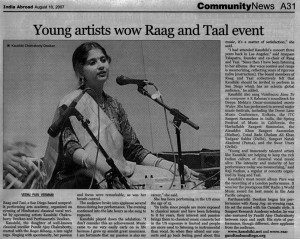
Een jubel-recensie voor Kaushiki na een concert in de Verenigde Staten, waar ze al sinds haar 15e optreedt (klik op de foto om te vergroten)
Naast opnamen van Kaushiki en andere vertegenwoordigers uit de Patiala Kasur school komt Kaushiki aan het woord over haar muziek en haar carrière. Ik interviewde haar dit voorjaar toen ze op concerttour was in Nederland.
De Noord-Indiase raga is Kaushiki met de paplepel ingegoten. Kaushiki was een muzikaal wonderkind. Ze kon volgens haar moeder, haar eerste guru, eerder zingen dan spreken. Al op haar tweede kon Kaushiki ingewikkelde melodieën en ritmes perfect nazingen, aldus moeder Chandana Chakrabarty. Kaushiki’s vader is de beroemde zanger Ajoy Chakrabarty. Hij bracht zijn dochter via mondelinge overdracht jarenlang de fijne kneepjes van de ragazang bij. Kaushiki: “Als kind oefende ik zo’n twee tot drie uur per dag. Later, als tiener, trainde ik jarenlang zo’n acht tot tien uur per dag. Hoe meer, hoe beter. Mijn vader was voor mij in al die jaren meer een leraar dan een vader, de leraar-leerling relatie prevaleerde boven de vader-dochter relatie. Ik weet dat mijn jeugd hierdoor heel anders en minder vrij was dan normaal, maar ik heb van de muziek een enorme beloning teruggekregen. Het beoefenen van Indiase klassieke muziek is als een manier van leven. Het doorgronden van haar dieptes en dimensies vereist een volledige, levenslange toewijding.”
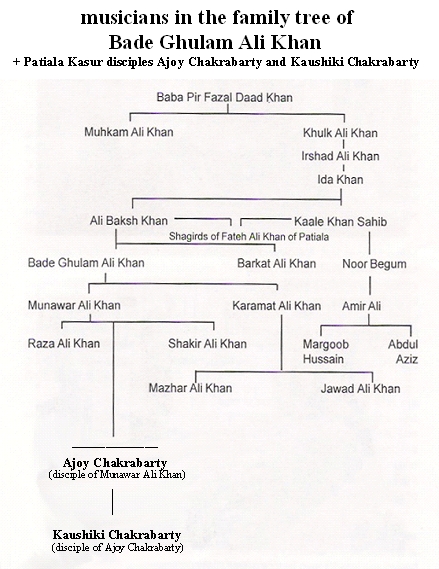
De Patiala Kasur gharana, met als middelpunt zanger Ustad Bade Ghulam Ali Khan
In 2005 won Kaushiki met haar album Pure de prestigieuze BBC World Music Award, voor haar een grote verrassing: ‘Ik had nooit verwacht dat een album met Indiase klassieke muziek zou winnen. Door de BBC Award is niet alleen mijn naam veel bekender geworden, maar het heeft ook veel meer mensen in het Westen in contact gebracht met Indiase klassieke muziek. Deze prijs inspireert me en moedigt me aan om nog harder te werken en nog beter te worden. Ik wil er alles aan doen om muziekliefhebbers overal ter wereld met deze muziek te laten kennismaken.’
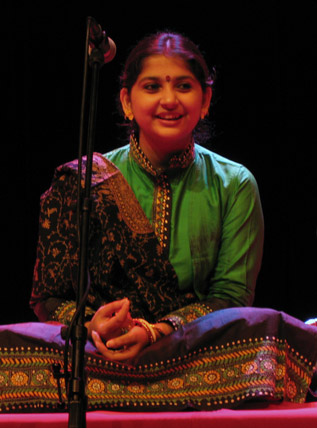
Kaushiki tijdens haar eerste optreden in Amsterdam in 2004
Kaushiki’s optredens worden gekenmerkt door een perfecte technische uitvoering met een maximale emotionele zeggingskracht. Achter de fenomenale techniek klinkt altijd warmte en menselijkheid en haar zang blijkt zowel de doorgewinterde ragaliefhebber als de leek recht in het hart te treffen. Kaushiki beheerst alle stijlen van de Noord-Indiase ragamuziek: de ascetische, formele dhrupad, de op techniek en virtuositeit gerichte khayal, de dramatiek van het romantische thumri-lied en de devotionele bhajan. Bovendien beoefent Kaushiki naast de Noord-Indiase muziek sinds eind jaren negentig ook de Zuid-Indiase ragazang, een muzikale wereld met een heel ander repertoire en andere zangtechnieken. Ook op dit terrein zijn Kaushiki’s vorderingen verbluffend. Geen wonder dat de jonge zangeres in korte tijd wereldwijd een grote schare bewonderaars heeft opgebouwd. De eerste aflevering van Gharana, over Kaushiki Chakrabarty en haar leerschool, is te beluisteren op vrijdag 30 november 2007, 20.00-21.30u. Wil je Kaushiki Chakrabarty niet alleen maar horen, bekijk dan op Youtube mijn video-portret (in 2 delen) van de zangeres.
NEW programme! GHARANA ; 1st episode: Kaushiki Chakrabarty ; broadcast: 30th nov. 2007
Gharana is my new programme for De Concertzender on the different gharana’s, or different schools, of North Indian raga music. This 90-minute programme will be aired four times a year. The first episode will be dedicated to Kaushiki Chakrabarty and the Patiala Kasur Gharana.
